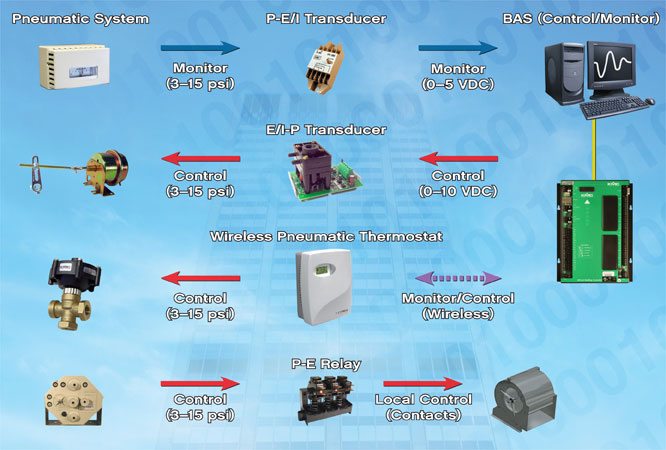Air Today, Digital Tomorrow: Pneumatic to BAS Conversions

Air Today AND Digital Today
New “green” commercial buildings typically have state-of-the-art digital Building Automation Systems (BAS). But new buildings are only a fraction of the sum of all buildings that include those constructed many decades ago, many of which have pneumatic systems. Retrofitting older energy-inefficient buildings is the green wave of the future.
However, it’s so much easier to install conduit, wires, and valves when a building is only half-finished than when walls and ceilings and HVAC equipment have already been in place for decades. Under these real-world conditions, digital conversions can range from moderately to prohibitively expensive, depending on how much “digitization” is performed:
- The most costly option is to rip out all the old pneumatic equipment and install new digital equivalents. Not only is this process very time-consuming, but parts or even all of the HVAC system may need to be shut down for periods of the retrofit, creating a great deal of inconvenience for the building’s occupants. This does, however, result in an energy-efficient, pure digital system.
- A more cost-effective and less disruptive option usually is to replace only the parts of the particular system that make the most sense and to leave the parts that can still perform adequately in place. This results in a pneumatic and digital hybrid, which can still be very efficient (in a similar way to the fuel efficiency of hybrid cars that combine the best of electric and gasoline technologies).
Applying new digital controls to old air handlers and roof top units is usually quite feasible and cost effective (although it may require adding electrical conduit and replacing valves). But what about ripping out old pneumatic actuators and thermostats from dozens or even hundreds of Variable Air Volume (VAV) boxes, and then running conduit as well as 24 VAC and networking wiring to all of the digital replacements? Labor costs for such awkward and tedious work become increasingly prohibitive as the number of VAV boxes goes up. Retrofitting VAV boxes is much more expensive than when installing new ones in new construction.
Going all digital is expensive. Going digital with just the “low-hanging fruit” of central operations doesn’t capitalize on all of digital’s capabilities for precision monitoring and controlling of an entire HVAC system, but it is often the most feasible option.
The “fruitful” middle ground involves leaving all the pneumatic damper actuators in place. This option can give the building owner virtually the same control as a full BAS but substantially softens the cost blow of converting to a BAS. Areas of labor and material savings include:
- Minimal conduit and wire needed to take control of the valves and dampers
- Much less 24 VAC power (fewer/smaller transformers) needed for a hybrid system than a pure digital system
- No need for a very expensive purchase and installation of new valves and damper motors
Pneumatic and Digital Communication
In a hybrid system, how do analog air pressures and binary electrical pulses talk with each other? To convert apples to oranges, transducers serve as communication intermediaries between these completely different entities.
For a pneumatic system to talk to a digital system, a P-E (pressure to voltage) or P-I (pressure to current) transducer is used. A KMC TPE-1001, for example, can take a 0–15 psi signal from pneumatic devices such as thermostats, transmitters, and receiver-controllers and convert it to any one of the three different outputs (0–5 VDC, 0–10 VDC, or 0–20 mA). Thus, a standard 3–15 psi signal can translate into a standard 4–20 mA or 2–10 VDC signal that serves as an input to a BAS, allowing the BAS to monitor the pneumatic operation.
When an electrical device just needs to be simply switched on or off based on a particular pressure, a proportional signal may be unnecessary and a simpler pneumatic-electric relay might do the job. The KMC CCE-3000 series or CCE-1001/1002 pneumatic-electric relays, for example, are ideal for applications such as starting fan coil unit fans, exhaust fans, and direct control of electric duct heaters.
But communication isn’t just a one way street. To gain energy efficiency, the BAS needs to control the pneumatic operation. The KMC XEC-300x series transducers, for example, convert an analog voltage (E) or current (I) signal from a BAS into a linear pneumatic (P) output signal for accurate positioning of damper and valve actuators used in HVAC systems. The transducers have three selectable input ranges. The analog signal may be either 1–5 VDC, 2–10 VDC, or 4–20 mA, which provides a linear 3–15 psi output signal to pneumatic devices.

Additional Options
Another solution to help “hybridize” and integrate pneumatic and digital control systems is to use wireless thermostats. KMC has an OEM relationship with Cypress Environsystems and builds the pneumatic thermostat heart of the award-winning Wireless Pneumatic Thermostat. Replacing existing pneumatic thermostats with wireless-capable devices greatly expands the monitor and control capabilities of a pneumatic system. And since thousands of feet of pneumatic tubing do not have to be torn out and replaced with electrical wiring, the time and cost required for installation of wireless two-way communicating thermostats is a tiny fraction of retrofitting with traditional electrically wired thermostats.
Of course nothing can last forever. KMC Controls (formerly Kreuter Manufacturing Company) pioneered pneumatic control devices for HVAC applications, was a leading participant as analog electronic controls took hold in buildings, and later established complete lines of fully programmable digital products. KMC understands both pneumatics and digital. When the time does come that a building’s venerable pneumatic system needs to retired and replaced (partially or entirely), we also have the proprietary KMDigital or open-protocol BACnet lines of digital products that will optimize your HVAC control.
Additional Resources
Pneumatics
Pneumatics for the 21st Century
Pneumatics Overview Brochure (SB-031)
Pneumatic Kits Brochure (SB-055)
Building Automation Systems
Understanding Building Automation and Control Systems
Small Building Automation (with the KMC Controls FlexStat)
Benefits of Controls in Green Buildings
Energy Management & Efficiency
Zone control with Variable Air Volume controls (VAV)